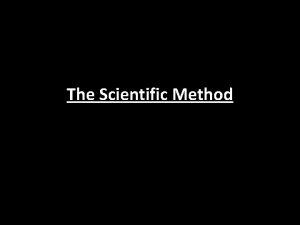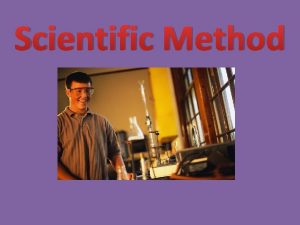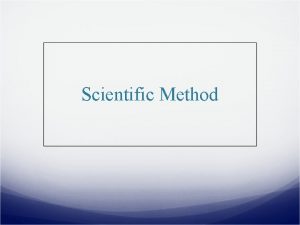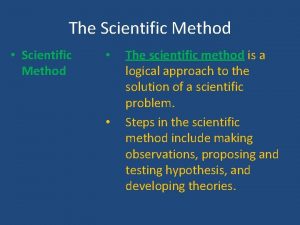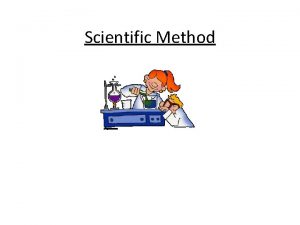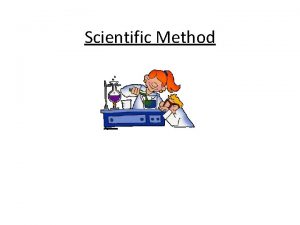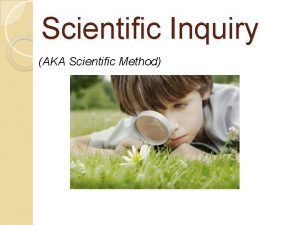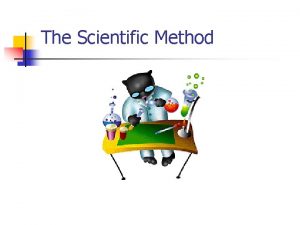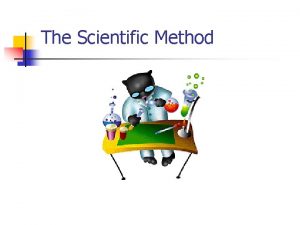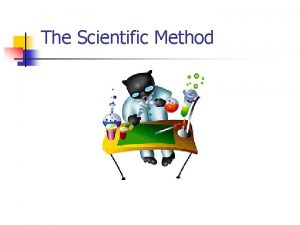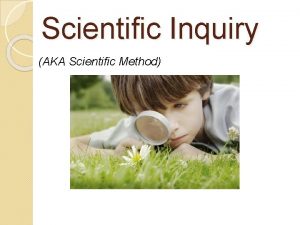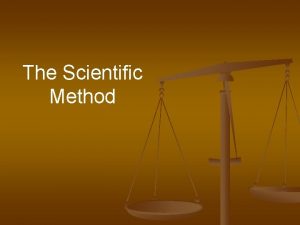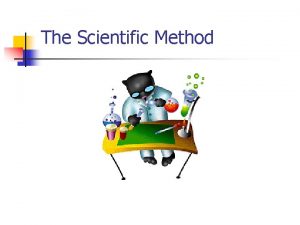The Scientific Method What is the Scientific Method





















- Slides: 21

The Scientific Method

What is the Scientific Method? • A systematic/organized way for scientists to solve a problem or answer a question. • There are 5 steps to the scientific method:

Step 1: Make Observations or Notice a Pattern • Before a hypothesis can be made, scientists first have to be curious and want to investigate a situation. – Ex. Jigsaw puzzles are difficult and time consuming for people of all ages to put together

Step 2: Form a Hypothesis • A hypothesis is a testable statement. • It can be proven right or wrong. • It is written in an “If … Then …” statement – Ex. If people are older, then it will take them less time to piece together a jigsaw puzzle.

Step 3: Design and run multiple experiments • Real scientists spend a large part of their career in this step of the scientific method • It might be necessary to revise your experiment and try another during this step in the sci method.

Step 4: Theory • If experimentation goes well, hypothesis was proven right or wrong, the results are considered to be your theory.

Step 5: Revised Theory / Law (Last step!) • Results may not always be considered a law • Move from theory to revised theory or law by members of the scientific community reproducing the same exact results of your experiment

Sci Method Observations Multiple observations or patterns Hypothesis “If…then…” statement Experimentation Design multiple experiments Theory Results of your experiment Revised Theory Sci. Community accepts exp.

Observations & Inferences

Observation vs Inference Observation Inference • Use of one or more of the senses—sight, hearing, touch, smell, and sometimes taste—to gather information • Ex: • Logical interpretation based on prior knowledge and experience • Ex: – Dr. Hall observes that students take 30 seconds to quiet down when asked – The Dodgers are in 1 st place – The students take 30 seconds to be quiet because it is hard to hear in a big class – The Dodgers are in 1 st place because they are playing well

Observation vs Inference • What do you observe about this picture? • What can you infer from this picture?

Identifying Variables & Sources of Error

3 Kinds of Variables • Independent Variable – something that is changed by the scientist – What is tested – What is manipulated • Dependent Variable – something that might be affected by the change in the independent variable – What is observed – What is measured – The data collected during the investigation

3 Kinds of Variables • Controlled Variable – a variable that is not changed – Also called constants – Allow for a “fair test”

For Example:

Students of different ages were given the same jigsaw puzzle to put together. They were timed to see how long it took to finish the puzzle.

Identify the variables in this investigation.

What was the independent variable? • Ages of the students –Different ages were tested by the scientist

What was the dependent variable? • The time it took to put the puzzle together –The time was observed and measured by the scientist

What was a controlled variable? • Same puzzle –All of the participants were tested with the same puzzle. –It would not have been a fair test if some had an easy 30 piece puzzle and some had a harder 500 piece puzzle.

Sources of Error • A source of error is any factor that may affect the outcome of an experiment • Experimental errors can be reduced by: – Using a large sample size – Repeating the experiment many times • Unavoidable experimental errors are errors due to variables beyond your control – Ex: weather
 Scientific inquiry vs scientific method
Scientific inquiry vs scientific method How is a scientific law different from a scientific theory?
How is a scientific law different from a scientific theory? Hát kết hợp bộ gõ cơ thể
Hát kết hợp bộ gõ cơ thể Frameset trong html5
Frameset trong html5 Bổ thể
Bổ thể Tỉ lệ cơ thể trẻ em
Tỉ lệ cơ thể trẻ em Voi kéo gỗ như thế nào
Voi kéo gỗ như thế nào Tư thế worm breton
Tư thế worm breton Hát lên người ơi alleluia
Hát lên người ơi alleluia Các môn thể thao bắt đầu bằng từ đua
Các môn thể thao bắt đầu bằng từ đua Thế nào là hệ số cao nhất
Thế nào là hệ số cao nhất Các châu lục và đại dương trên thế giới
Các châu lục và đại dương trên thế giới Công thức tính độ biến thiên đông lượng
Công thức tính độ biến thiên đông lượng Trời xanh đây là của chúng ta thể thơ
Trời xanh đây là của chúng ta thể thơ Mật thư tọa độ 5x5
Mật thư tọa độ 5x5 Phép trừ bù
Phép trừ bù Phản ứng thế ankan
Phản ứng thế ankan Các châu lục và đại dương trên thế giới
Các châu lục và đại dương trên thế giới Thơ thất ngôn tứ tuyệt đường luật
Thơ thất ngôn tứ tuyệt đường luật Quá trình desamine hóa có thể tạo ra
Quá trình desamine hóa có thể tạo ra Một số thể thơ truyền thống
Một số thể thơ truyền thống Cái miệng nó xinh thế
Cái miệng nó xinh thế

























